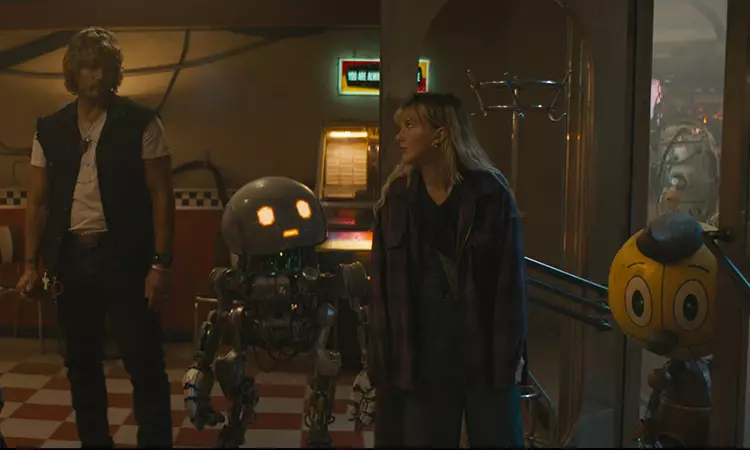The realm of science fiction often serves as a playground for grand ideas and complex narratives. With “The Electric State,” a visual feast born from the minds of the Russo brothers, this genre sees a sophisticated revival. Their latest venture, built on Simon Stålenhag’s enthralling graphic novel, unfolds in an alternate version of the 1990s, where the fusion of nostalgic Americana and monstrous, sentient technology creates a strikingly original backdrop. This adaptation promises both thrill and depth but proves to be a mixed bag, triumphantly captivating in visuals while ambivalent in storytelling.
At the heart of this narrative lies Michelle, portrayed by Millie Bobby Brown, a brave teenager driven by the desperate quest to find her missing brother in a landscape that eerily mirrors societal breakdown. As she traverses this dystopian world, aided by Cosmo, her quirky robotic companion, and Keats, a dubious smuggler played by Chris Pratt, the audience is granted a glimpse into a hauntingly beautiful yet terrifyingly chaotic universe. In essence, “The Electric State” encapsulates a clash of human resilience and technological despair, forcing viewers to confront both heart-wrenching emotions and visceral action.
Visual Mastery: A Landscape Like No Other
The most iconic element of “The Electric State” is undoubtedly its stunning visual design. Each frame immerses the viewer in a world where mechanical relics loom, and derelict landscapes evoke feelings of nostalgia mixed with dread. The Russo brothers, supported by their production team, have done an immaculate job of evocating Stålenhag’s unique retro-futuristic aesthetics. From the desolate highways to towering robots that seem to whisper remnants of a forgotten civilization, every moment feels like a carefully curated piece of art.
However, while visual depth abounds, the narrative often falters. The film’s screenplay, penned by Christopher Markus and Stephen McFeely, moves with a relentless pace that occasionally sacrifices character development for explosive sequences. Though the audience may be visually captivated, the emotional weight of the story sometimes feels overshadowed by its dazzling spectacle, leaving some key themes—such as the entwined destinies of humanity and machines—underexplored. The film struggles to find equilibrium, oscillating between moments of profundity and sheer action, which can dilute the gravity of its more poignant themes.
Characters in Search of Depth
While Brown’s portrayal of Michelle shines, showcasing moments of tenacity and vulnerability, the character is often left wanting. The potential for an in-depth exploration of a young girl grappling with loss and mystery is tantalizing yet unmet. Similarly, Chris Pratt’s Keats oscillates between a roguish charm and a sense of redundancy, treading familiar territory without adding new dimensions to his archetype. This stagnation in character development is particularly disheartening given the quality of the talented supporting cast, including luminaries such as Stanley Tucci and Giancarlo Esposito. Unfortunately, instead of enriching the storyline, several characters drift into the background, their potential tragically unrealized.
The film flirts with deeper explorations of memory, loss, and the entwined nature of humanity and technology—intriguing themes that, if fully developed, would have elevated the narrative substantially. However, these moments often feel like a mere whisper amidst the louder, more frenetic sequences that fill the film. As engaging as the relentless action may be, it raises the question: what value does it hold if the characters remain sketches rather than fully realized individuals?
An Explosive Yet Incomplete Journey
Despite its shortcomings, “The Electric State” emerges as an engaging cinematic experience. The stunning visuals captivate, and the themes it attempts to explore resonate on a surface level, encouraging a contemplation of humanity’s fragile relationship with technology. However, one cannot help but feel that the film, while ambitious, lacks the depth required to truly soar. It inspires awe but also a sense of yearning—yearning for a narrative that should have matched its visual prowess with an equal emotional weight.
In the end, “The Electric State” is a testament to the Russo brothers’ ability to conjure beauty and wonder, albeit one that leaves audiences craving a narrative as bold and imaginative as its visual storytelling. As a journey through chaos, it reminds us that even amidst ruins, there lies potential for greatness—if only we could delve deeper.

